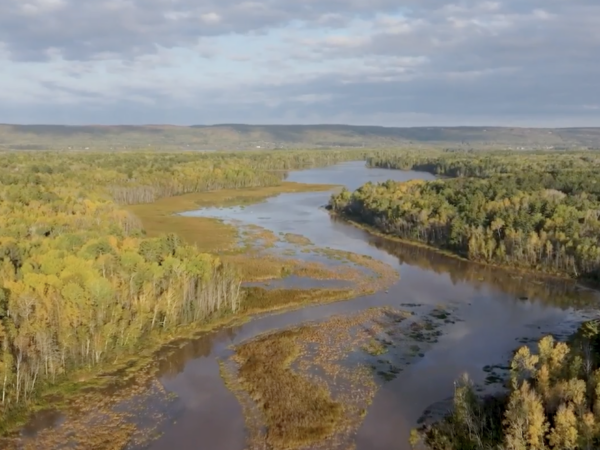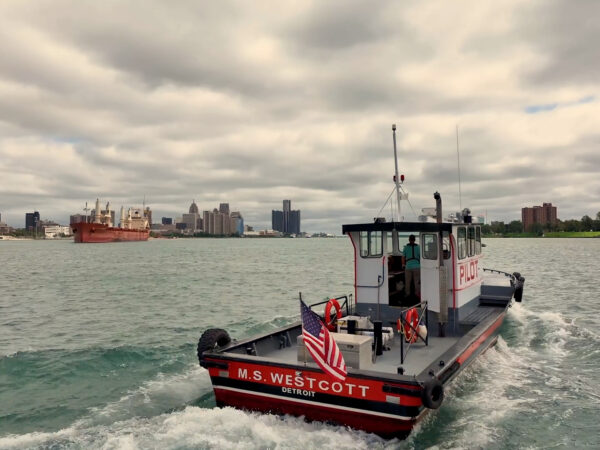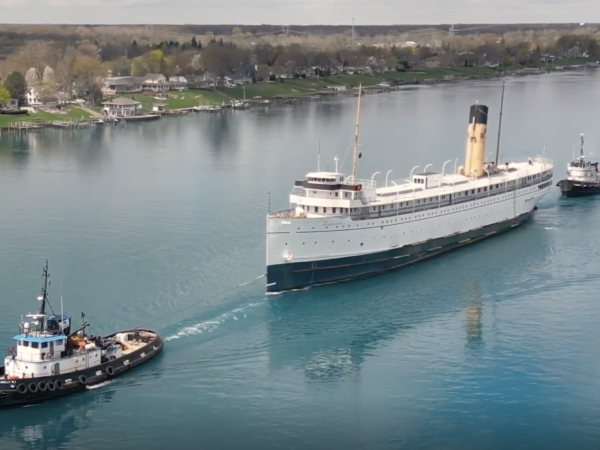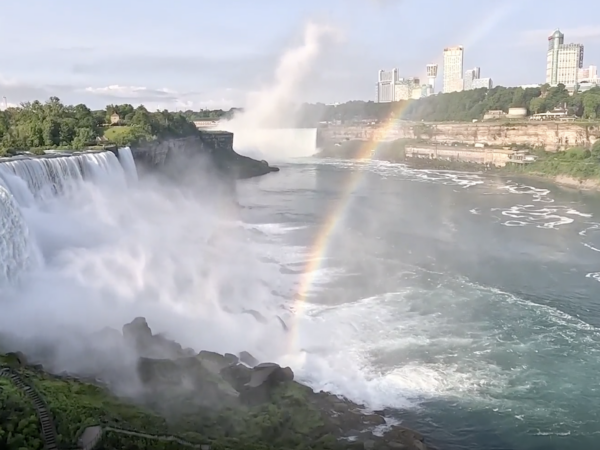IN THIS EPISODE:
Michigan DNR researchers document the northern madtom – a tiny, endangered catfish that’s venomous. Then take a cinematic journey through Earth’s largest freshwater ecosystem – the Great Lakes watershed – with a preview of a new documentary series. And “The Catch” has news about the lakes you love.
WHERE WE TAKE YOU IN NOVEMBER
GREAT LAKES LEARNING:
Explore this month’s hands-on lesson plans designed to help your middle schoolers understand the Great Lakes — all at home or in the classroom. They’re aligned to education standards AND free to download.
Lesson Plans
Have a question about the Great Lakes or life in the region?
Ask Great Lakes Now, and if we can answer it, we might loop it into our coverage so others can learn too.
Submit Your Question
When to Watch?
Check your local station for when Great Lakes Now is on in your area.
Premieres on DPTV
Wednesday, November 30, at 7:30 PM
STATIONS CARRYING THE SERIES
DPTV
Detroit, Michigan
WEAO
Akron, Ohio
WNEO-TV
Alliance, Ohio
WCML-TV
Alpena, Michigan
WDCP-TV
Bad Axe, Michigan
BCTV
Bay County, Michigan
WBGU-TV
Bowling Green, Ohio
WNED-TV
Buffalo, New York
WCMV-TV
Cadillac, Michigan
WTTW-TV
Chicago, Illinois
WVIZ-TV
Cleveland, Ohio
WKAR-TV
East Lansing, Michigan
WQLN-TV
Erie, Pennsylvania
WCMZ-TV
Flint, Michigan
WGVU-TV
Grand Rapids, Michigan
WPNE-TV
Green Bay, Wisconsin
WGVK-TV
Kalamazoo, Michigan
WHLA-TV
La Crosse, Wisconsin
WHA-TV
Madison, Wisconsin
WNMU-TV
Marquette, Michigan
WHWC-TV
Menomonie-Eau Claire, Wisconsin
WMVS-TV
Milwaukee, Wisconsin
WCMU-TV
Mt. Pleasant, Michigan
WLEF-TV
Park Falls, Wisconsin
WNIT-TV
South Bend, Indiana
WCNY-TV
Syracuse, New York
WGTE-TV
Toledo, Ohio
WDCQ-TV
University Center, Michigan
WNPI-TV
Watertown, New York for Ontario signal
WPBS-TV
Watertown, New York for U.S. signal
WHRM-TV
Wausau, Wisconsin

Researchers donned scuba gear to dive into the St. Clair River to learn more about the nesting behaviors of northern madtoms.
Searching for Madtoms
SEGMENT 1 | Marysville, Michigan
Northern madtom are tiny catfish that most anglers will go their entire lives and never encounter. So why are they of interest to Michigan Department of Natural Resources research biologists Jan-Michael Hessenauer and Brad Utrup?
Because these tiny fish play an important role in the ecosystem as an indicator species, Hennsenauer says. Their presence or absence can tell researchers a great deal about the health of a river system. And these researchers were particularly interested to learn more about where and when the madtoms nest.
How deep was the water? What type of habitat did they use? What kind of structures did they prefer? The answers to these questions and others would help guide future fisheries management plans.
A small population of northern madtoms was known to inhabit the lower St. Clair River, and Hessenauer and Utrup wanted to study the fish. But to do that, first they would have to become certified divers.
Greg Lashbrook is a professional underwater cameraman who has shot several stories for Great Lakes Now. Over the years, Lashbrook has worked with the U.S. Fish and Wildlife Service, NOAA, Fishes and Oceans Canada, Little River Band of Ottawa Indians, Michigan DNR and national broadcasters from Discover’s Animal Planet to National Geographic.
When Hessenauer and Utrup were ready to start looking for madtom nests, they turned to Lashbrook for help. Working together, the divers set out to find and document northern madtoms in the St. Clair River.
Go along with them.
Here is other Great Lakes Now work by Kathy Johnson, who produced this segment:
I Speak for the Fish: No petting for these cats
I Speak for the Fish: A jarring look at gizzard shad
I Speak for the Fish: Inside a trout feeding frenzy
For more Great Lakes Now stories about fish in the Great Lakes:

A pair of wolf pups as captured in an episode of “Great Lakes Untamed.”
Great Lakes in the Spotlight
SEGMENT 2 | Throughout the Great Lakes Watershed and the UK
A new three-part documentary series is taking viewers inside one of the largest freshwater ecosystems on Earth: the Great Lakes watershed. Through amazing cinematography, the series captures the stories of the wildlife that call this vast ecosystem home.
“Great Lakes Untamed,” is an international project that took more than 3 years to complete and features the work of some of the world’s most talented cinematographers. The project was led by veteran BBC nature documentarian, Ted Oakes, who grew up along the Ottawa River in Canada and developed a fascination for the Great Lakes as a young boy in Canada.
“I’ve been making wildlife shows for BBC here in the UK for 25 years and no one had ever really turned that big budget lens on the Great Lakes watershed and all the natural history of the watershed,” said Oakes.
The series explores some Great Lakes mysteries, from Canada’s longest underwater cave system to flying squirrels that glow in the dark.
According to Oakes, most films about the Great Lakes focus on the environmental challenges and the damage that has been done to the Lakes. He says his team was committed to creating a film that showcased the natural beauty of the watershed as a way to encourage viewers to appreciate and protect the region.
“We felt it was important that the television series was reminding people what we have to lose and how beautiful the Great Lakes watershed is.”
Here’s how you can watch the documentary, which aired on TVO in Canada and is presented on the Smithsonian Channel in the United States. Links below!
Smithsonian Channel in the U.S.
Here is other Great Lakes Now work on animals of the region:
With wolf plan complete, Michiganders lobby state on possibility of a hunt

As part of a binational effort called the Great Lakes Plastic Cleanup, beachgoers might start noticing remote-controlled robots picking up trash along the shorelines of the Great Lakes.
The Catch: News about the Lakes You Love
SEGMENT 3 | Northern Minnesota, Cleveland, Ohio, Grand Marais, Minnesota
Keep up with the Great Lakes’ biggest issues. Find out how environmental challenges are impacting your enjoyment of the outdoors and the health of the ecosystem. Go beyond the headlines with reporters from around the region.
This segment – The Catch – in our award-winning PBS program will keep you in the know. This month, stories about penalties for Enbridge, beach-cleaning robots, and a new Great Lakes Now column, “Nibi Chronicles.”
First up, a story from Minnesota Public Radio’s Kirsti Marohn, who has been following news about Enbridge Energy regarding Line 3. Enbridge is facing government action and criminal charges stemming from violations during the construction of the Line 3 pipeline in Northern Minnesota.
“Several state agencies and one Native American tribe, the Fond du Lac Band of Lake Superior Chippewa, announced this enforcement action against Enbridge,” said Marohn.
In addition to the state agencies, Minnesota Attorney General Keith Ellison’s office has filed one misdemeanor count against Enbridge in Clearwater County District Court for using state waters without a permit.
Next, Zaria Johnson of Ideastream Public Media talks about a new fleet of remote-controlled robots coming to Great Lakes shorelines in spring of 2023. The bots will collect plastic pollution from both the shoreline and the water as part of a larger binational effort called the Great Lakes Plastic Cleanup initiative.
“The Great Lakes Plastic Cleanup Initiative is a partnership between two organizations that are based in Canada, and that’s the Council of the Great Lakes Region and Pollution Probe,” said Johnson.
Finally, a conversation with a new contributor to Great Lakes Now, Staci Drouillard, the writer behind a new column, “Nibi Chronicles.” Nibi is the Ojibwe word for water. “I thought it was a natural title for a column about the Great Lakes, and specifically where I live here on the north shore of Lake Superior,” said Drouillard.
Based in Grand Marais, Minnesota, Drouillard is a Grand Portage Ojibwe direct descendant, and her father is a band member. Drouillard hopes to infuse “Nibi Chronicles” with ideas rooted in the interconnections that are a crucial part of how she views the natural world.
Read her first column HERE.
Find all The Catch segments HERE.
Videos from Episode 2211
Subscribe on YouTube
Featured Articles
Digital Credits
The Great Lakes Now Series is produced by Rob Green and Sandra Svoboda.


















